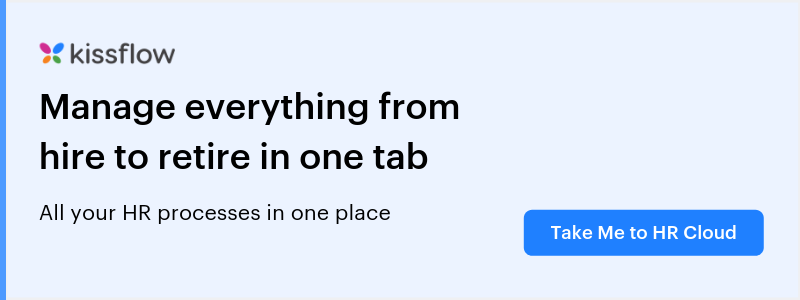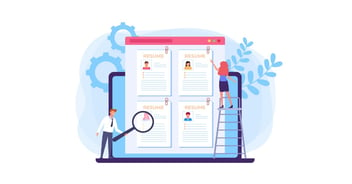More and more organizations are investing in technology to manage their human resources (HR) activities and processes. One of the most popular software programs is proving to be applicant tracking systems. This is likely because recruitment automation is widely regarded as being a time-consuming and administratively heavy process for HR teams. However, recruitment is vital to organizational success.
Let’s further explore what an applicant tracking system is and some of the key benefits that using one could bring to your business.
What is an applicant tracking system?
An applicant tracking system (ATS) is a tool that can help manage your company’s end-to-end recruitment process. With an ATS, you can post job ads, assess potential talent, track interview processes, evaluate candidate performance, send job offers, and hire the right candidate. An ATS provides customized reports and insights that improve and speed up decision making.
Hiring managers can send automated emails to candidates to let them know that their application has been received, and they can also schedule interviews or email rejection letters.
The many advantages of an application tracking system include:
There are lots of different types of applicant tracking systems on the market. These programs vary from software that is simple and accessible in design, to more advanced and comprehensive systems that can seamlessly handle the end to end recruitment activities.
Things to keep in mind when choosing an applicant tracking system
We will talk in more detail later in this article about the specific features you should expect your ATS to have to offer your business the best value for money. In addition to such features, however, there are some other factors you should consider when deciding when to take the plunge and invest in an ATS.
1. What pricing structure does the applicant tracking system offer?
Consider whether you would be charged per user or pay a set monthly price. The latter is potentially fairer and allows you to budget more easily. In addition, this option allows you to future proof your needs, as you won’t end up paying more if your business expands in the future.
2. How is the implementation period structured?
This is an important area to consider, as complicated and long-winded setups can cost you valuable time, money, and staff resources. Data migration is usually a key point to consider since your business probably has existing data that needs to be transferred to the new platform. Make sure that any additional costs relating to the implementation process are laid out clearly in advance. You should also be clear on the training strategy offered, including how the HR team will be trained and what ongoing support they will be offered.
3. Can the system grow with your business?
It is imperative that the recruitment software you choose is in tune with your current business needs, including its size, your budget, the type of features you will find most valuable, etc. You should also take the time to look to the future and make a calculated assessment of what your needs could be at that time. If you choose an ATS with the scale and functionality to grow with your business, it will save you a lot of time, inconvenience, and money switching platforms later.
Tangible benefits that come with an applicant tracking system
There are many reasons to invest in a robust ATS for your business, but the following three factors are the most significant.
1. Reduction in the time to hire rate
This metric measures the length of time it takes to recruit for an open role, from the time it is scoped out and authorized, to the time a job offer is made to a successful candidate.
There are many parts to this process and tasks spread across multiple parties, from line managers and HR teams to recruitment agencies and candidates themselves. Thus, delays inevitably occur, and valuable man-hours are often spent chasing individuals to complete various tasks. These tasks include laborious manual activities such as cross-referencing CVs or scheduling interviews. A solid ATS can automate many of these tasks, thus noticeably speeding up these parts of the process. For example, using pre-built keyword matches to screen CVs is an efficient way to quickly determine that the quality of applications is fast, accurate, and effective.
2. Lower cost per hire rate
A big advantage of using an ATS is that your average cost per hire is likely to be reduced. This means the business will have to invest less money into the recruitment and selection process of new employees.
There are several reasons for this. The most significant is linked to the point above and the fact that the whole process takes less time, with fewer man-hours having to be invested in carrying out manual tasks. In addition, the ability to create and maintain talent pools of suitable candidates for future vacancies is an effective way to cut recruitment costs. Now, the recruitment process does not have to start from scratch each time a new vacancy is identified.
Finally, the most advanced ATS offers useful functionality to analyze the recruitment CRM initiatives and hiring sources that produce the best yield. This allows you to allocate the recruitment budget to the most effective forms of hiring to get the best results at the lowest price.
3. Improved quality of hires
Finally, a good applicant tracking system can transform the quality of the candidates that you recruit. First, the fact that the ATS helps to speed up the entire hiring process enables your business to quickly attract and target the best talent in a competitive recruitment market. Some of the automated features of the system, such as slick screening questionnaires, quick interview scheduling, and auto email communication, can also help the best candidates to engage with your company. Often, they will actively choose you over your competitors, working with you longer and even referring like-minded candidates to your business.
Top features common to the best applicant tracking systems
It can be tricky for an organization that is just starting out looking for an applicant tracking system to know which software on the market has the potential to effectively meet its needs. While features and functionalities inevitably vary between providers, there are some essential features that the best ATS possesses that are worth watching out for.
A central database or dashboard that compiles applicants’ CVs and application statuses is a vital feature. This function enables HR teams and line managers to quickly and easily view current job applicants, make speedy comparisons across their skills experience, and also create useful talent pools of applicants for future roles.
The functionality of one-click job postings to multiple job boards is also a useful feature. This means that your jobs can go live immediately and target candidates via sources that are proven to be successful.
Finally, the ability to quickly and easily set up interviews with shortlisted candidates, as well as utilize a range of interview resources such as assessment matrices and scorecards, is a valuable feature.
The best applicant tracking systems on the market right now
Many choices are available for different types of ATS. It can be hard to know where to start.
Here’s our pick of the best applicant tracking systems out there.
1. Kissflow HR Cloud
Kissflow offers a unique and effective way of attracting and hiring the best talent on the market with its easy-to-use, customizable applicant tracking system that forms part of its extensive HR Cloud solution. It offers smart job publishing, allowing recruiters to quickly send open jobs to a range of job portals in one click, as well as an innovative feature like internal talent pool and built-in collaboration platform to enable real-time communication between all members of the hiring teams and customizable workflows designed to match your recruitment processes perfectly.
2. Zoho Recruit
Zoho Recruit is a scalable HR tool that offers a robust applicant tracking system on a web-based application. It offers all of the usual features of the best ATS, such as automated job board posting, CV matching, and interview scheduling, along with an easy-to-use candidate portal for increased applicant engagement.
3. Pinpoint
A good solution for small and medium-sized organizations, Pinpoint offers clear and straightforward functionality on a cloud-based system. It offers useful options to customize the site using your own company branding. Pinpoint incorporates features such as interview scheduling tools, custom-designed application forms, and good reporting capability.
Do your research to find the perfect ATS for your organization’s needs
Making the decision to invest in an ATS is only the beginning. As you navigate the market for the system that is right for you, don’t be afraid to ask difficult questions, request free demonstrations, or dig deeper into the areas covered above to ensure that you invest in a system that has no hidden surprises and matches your organizational needs perfectly.








.webp)



